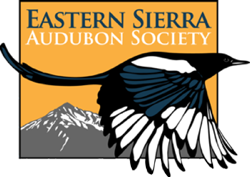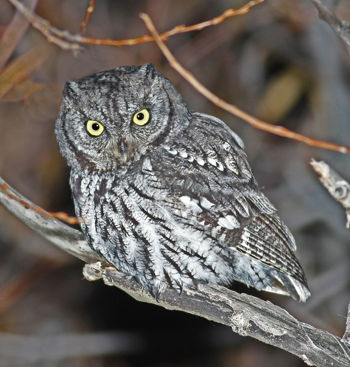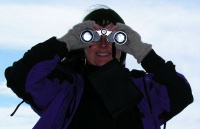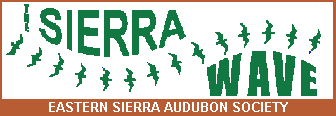
Eastern Sierra Audubon
Sierra Wave Newsletter
Volume 30, Number 3
January-February, 2012
Contents
- Events:
- Features:
- Reports:
- Business
Events
February 1st - NEW! Little-known Ethiopia: a birder's dream
Tall mountains, lush forests, fertile land and unique birds and animals: could this possibly be Ethiopia? Well, yes. Due to its diverse habitats, Ethiopia is one of the most species-rich countries in all of Africa. Matthew Matthiessen will describe this northeastern African country with its unique bird life as well as its ancient Christian history at 7pm on Wednesday, February 1st at the White Mountain Research Station. Matthew is known for his engaging manner, stunning photos, and impressive command of his subject.

Malachite Kingfisher, Lake Assawa, Ethiopia
Photo by Matthew Matthiessen
In February 2010, Matthew joined an international team of birders that observed and compiled a longer list of Ethiopian birds than any prior group. Their list of 526 species included Prince Ruspoli's Turaco, a magnificent bird of red, greens and blues, an array of starlings, and many other birds.
Ethiopia is the tenth African country Matthew has birded, and he believes it is a must for any serious birder wishing to expand their list of African species. Its variety of habitats, which range from some of the hottest on the continent to high alpine peaks, account for its large number of endemic species (species found nowhere else in the world). A bonus for birders seeking montane species is an all-season road at over 14,000 feet.
Christianity was officially adopted as the state religion of Ethiopia in the fourth century and it remains dominant to this day. Matthew will also treat us to images of the famous rock-hewn churches of Lalibela, which has been named a World Heritage Site.
Matthew comes to us from the Peregrine Audubon Society in Ukiah, where he first gave this presentation in May 2010, and we are delighted to have him offer it here. We are especially grateful because of the last minute cancellation of our previously-scheduled speaker, that we have Matthew as our newest board member, with such a wonderful program at the ready to step in and offer as a replacement!
The program is free of charge and the public is welcome!
NOTE: Originally scheduled program for February 1st (Reptiles and Amphibians of the Great Basin with Laura Cunningham) cancelled (or postponed)
As of January 25th, Laura Cunningham has had to cancel her February 1st Reptiles and Amphibians program. We are working with her to offer it at a later date, and will post an update here as soon as we know - we apologize for the last minute change, but we think you will LOVE the replacement program we are offering (see above)!
Back to Top
Future Eastern Sierra Audubon Programs:
April 26th, 2012: Birds of Midway Atoll
Midway Atoll (mid-way between the U.S. mainland and Japan) is important for many historical and biological reasons. Today it is part of three federal designations: Midway Atoll National Wildlife Refuge, Papahānaumokuākea Marine National Monument, and the Battle of Midway National Memorial. Well over a million seabirds use the three tiny islands in the atoll to bread each season, including over half of the world's population of Laysan Albatross. Join professional wildlife photographer Bob Steele as we explore the human and natural history of this unique and fascinating place.
Everyone is welcome to attend all programs!
Back to Top
Upcoming ESAS Field Trips
A Morning of Birding With Jon Dunn, Wednesday, January 11th, 2012
Leader: Jon Dunn
Jon will lead us to where the birds might be, perhaps as far as Tinemaha Reservoir. Meet at 8:00 a.m. in the parking lot just west of Bishop's Joseph's Market. We'll spend the morning "in the field." Bring liquids, warm clothes, binoculars, spotting scopes, snacks. For more information contact field trip coordinator Larry Nahm at 872-4125.
Back to Top
Birding Sand Canyon with Kerncrest Audubon, Saturday January 28th, 2012
Leaders: Bob and Susan Steele
Join us for a moderate hike (4-6 miles round trip with 400’ elevation gain) up Sand Canyon. We will start our walk in Kern County and walk up into the burn area that is in Inyo County. We will be targeting some of the ten species of woodpeckers and sapsuckers that have been seen in the canyon. We will also look for Brown Towhee, California Thrasher, and Wrentit.
Meet at 9AM on January 28 at Sand Canyon Road. This is south of Pearsonville, and just south of Brown Road. Look for an unmarked dirt road to the west (you’ll be able to see the sand quarry). This will be an all day hike, so bring lunch, and water. Expect 2 hours and 15 minutes travel time from Bishop. Carpoolers can meet behind Bishop's Joseph's Market at 6:30 a.m.
Back to Top
Round Valley Birding, Saturday February 11th, 2012
Leader: Larry Nahm
Beautiful Round Valley attracts hawks and owls which patrol its many fields. We'll amble along a couple of its roads, seeking raptors and their prey species. Will the Turkey Vultures have returned? Meet at 8:30 a.m. just west of the junction of U.S. 395 and Pine Creek Road, about twelve miles north of Bishop. For more information call Larry Nahm at 872-4125. Bring warm clothes, binoculars, snacks, water. The outing will end by noon.
Back to Top
Big Pine Winter Wildlife Tour, Saturday February 25th, 2012
Leaders: Tom and Jo Heindel
Tom and Jo Heindel annually lead a popular auto excursion between Klondike Lake and Tinemaha Reservoir. Mountain Bluebirds, Bald Eagles, bobcat, elk, owls, creepers, mergansers, sparrows and swans – these are examples of species which have turned up on past tours. Meet at 8:00 a.m. at Glacier View Campground off U.S. 395 just north of Big Pine. Bring water, snacks, binoculars, scopes. The outing should end mid-day. For more information please call the leaders at 938-2764.
Back to Top
Features
President’s Message
“The bird hunting the locust
is unaware of the hawk hunting him.”
— Proverb

Cooper's Hawk
ESAS partnered with Eastern Sierra Wildlife Care to present a booth about hawks at the Sierra Discovery Day in November. The highlight was the presence of ESWC’s Red-tailed Hawk “Spirit” who spent well over an hour perched on its handler’s wrist to the delight of more than forty people. People were encouraged and instructed about how to approach the hawk without alarming it. As is usual, the children were the first to step up. One small boy gazed up at the bird with an expression of awe and amazement. He captured perfectly, my feelings at being in the presence of the hawk.
Every few moments, I had to reassure myself that I was actually close enough to this creature to touch it. The details were absorbing. The colors of the feathers and the obvious strength of the talons and beak held my attention and teased at my imagination of how there can be creatures that fly. The eye captivated and, in a sense, frightened me. It was truly an eye in which one could become lost as I tried to sense what it could see; what was it that held its attention as it held my own.
As incredible as the bird’s appearance was, it is not what I now remember most. It exuded a sense of wildness which still impacts my senses as I think about the experience. Although Spirit had a devastating encounter with a power line which left it unable to fly, this was in no way a pet. The aura of the hawk was humbling and begged the question of what kind of bargain trades my use of electricity for its flight.
There is a Cooper’s Hawk that hangs around our house. Once or twice a week, I see it perched on fence or tree and even on the patio within fifteen feet of the window. Although a frequent sight, it is by no means familiar. I have a surge of excited privilege every time. I know the bird is not large; but it seems to me to be immense with the way it captures my mind and imagination. I whisper a wish that it will be safe from harm and return again soon.
We are not the caretakers of these and all other creatures. It is not our role to provide for them. We all share the same finite pool of resources and opportunities. Hunting eagles for a bounty because of the “harm” they supposedly do to livestock represents an incredibly poor vision of sharing, but there are many more examples that speak to the arrogance of humans in defining their “fair share”. Often, these negative impacts are not so much purposeful, but rather the result of a lack of information. ESAS and similar organizations have the ability to communicate the wonders of these birds and the habitats upon which they depend. That is the first step in convincing people to take a second look at what they consider to be their “share.” We cannot ask someone to act on behalf of the birds unless that someone finds value and spiritual worth in them.
Hopefully, we will continue to pursue that objective in the New Year. To that end, we welcome two new members to the chapter’s Board of Directors.
ESAS Board Welcomes New Members: Jenny Richardson and Matthew Matthiessen
Jenny Richardson has an educational and professional background in wildlife ecology and botany and has worked on research and management projects for a variety of species and habitats. During a bird banding internship in 2006, she handled her first Western Tanager and discovered a fascination to all things feathered. She moved to Bishop with her husband and canine family, Lucy and Goose, during the summer of 2008 and together they enjoy learning about, chasing, and barking at the avian life of the area (the dogs, not Jenny!).
While serving on the board, she hopes to contribute towards local conservation issues, participate in Eastern Sierra Audubon Society projects and programs and continue to promote enthusiasm for our charming and amusing bird friends!
Matthew Matthiessen is a recent transplant to the Eastern Sierra, moving to Mammoth Lakes in August 2010. Prior to that, Matthew lived in Ukiah, where he served as Controller of Ukiah Valley Medical Center for 11 years. In Ukiah, Matthew was actively involved with the birding community and Peregrine Audubon Society, for which he also served on the board. Matthew started birding at the age of eight and has been an avid birder ever since. Recently he's developed a dragonfly addiction as well. Currently Matthew is the Controller at Mammoth Hospital and is looking forward to getting to know the ESAS family.
He is looking forward to serving on the Eastern Sierra Audubon board and working with the other board members. Serving on the board of Peregrine Audubon Society in Ukiah was very enlightening and he hopes to bring that knowledge to ESAS. In particular he hopes to increase the ESAS presence in Mammoth Lakes as well as attract larger audiences, particularly young people, to our excellent ESAS programs.
Owens Lake Master Plan Draft Has Been Released
The first full draft of the Owens Lake Master Plan has been released to the planning committee stakeholders for their review and comment. It is really rewarding to be able to hold the document in one’s hand (after a long, long download). Audubon members will be interested in the habitat section which includes the objective that whatever activities occur on the lake, they will result in no net-loss of habitat value. This objective is co-equal with the other goals of the plan. This means that no objective, be it dust-control, water conservation or renewable energy will be achieved at the expense of the habitat and bird resources.
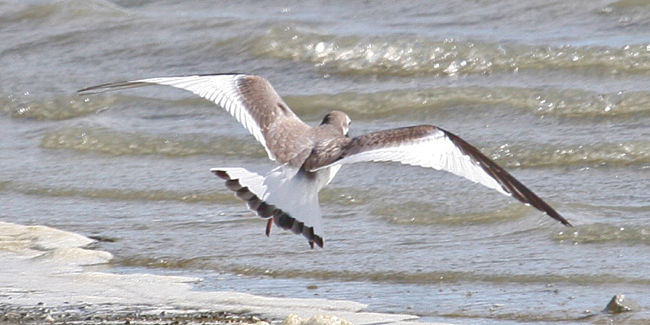
Sabine's Gull at Owens Lake, photo by Kelli Levinson
That habitat section also contains a “habitat suitability model” which identifies habitat characteristics which must exist to sustain the lake’s various bird species. The model sets out a framework to describe that habitat both in terms of geographical size and quality of resources. This model will be used to catalog existing conditions and then monitor the health of the lake and the impacts of present and future activities. This monitoring, in turn will lead to adaptive management practices designed to sustain Owens Lake’s bird resources far into the future.
Stakeholder comments are due on February 6 and the stakeholder group will meet on February 15th in Keeler to act on the comments and put the plan into final form for adoption. You can keep up with his process by going to the planning project website Owenslakebed. If you have questions or comments, contact Pete Pumphrey for more details.
Pete Pumphrey
Back to Top
Fall Migration in Inyo County 2011
[Birds in bold type have a photo in the article - click on any photo to see all in a slideshow]
By Tom & Jo Heindel
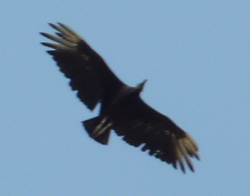
Black Vulture, a first for Inyo County
photo by Jon Dunn
In the Eastern Sierra, fall migration is first noted by mid June when female Wilson’s Phalaropes reappear after turning over parental duties to the males and moving towards their wintering grounds. Confirmation of the impending arrival of fall is further indicated by late June when the first shorebirds and Rufous Hummingbirds return. Although fall migration can extend from June to January, the time designated as fall in North American Birds is 1 August to 30 November.
This was yet another exciting fall migration period for the Eastern Sierra. At the top of the list were four species considered so rare in the state that their acceptance must be reviewed by the California Bird Records Committee. All were well photographed making the reviews a little easier. First was a Black Vulture, a first record for Inyo County and 5th record for the state, if accepted by the Committee. Jon Dunn saw the bird 5 August soaring with Turkey Vultures over Hwy 395 just north of Lone Pine. He immediately began calling locals and taking images of the bird soaring directly over his head. A number of birders headed to Lone Pine and spent hours, then a couple of days, without relocating the bird.
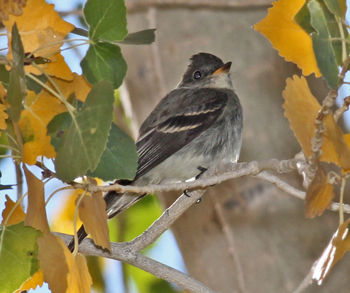
Eastern Wood-Pewee, photo by Tom Heindel
Next was an Eastern Wood-Pewee that Jim & Debby Parker discovered in Birchim Canyon 22 October. Because Eastern and Western Wood-Pewees are incredibly difficult to distinguish, the Parkers were appropriately cautious. They notified local birders and began compiling a photographic inventory all the while listening for the clinching, characteristic call. It was not until they heard the bird that they claimed an Eastern Wood-Pewee. The bird remained to 26 October allowing most observers to learn the fine details from Jon Dunn on why it was an Eastern Wood-Pewee and some were treated to hearing it call. If accepted by the Committee, this will be the first Inyo County record and the 12th for California.
The final two CBRC review listed species were from the southeast tip of Inyo County in Shoshone. A Wood Thrush came to the pond in Len Warren’s yard on 25 October and lingered to 8 November allowing a large number of birders the opportunity to add another tick to their Inyo County list. Len took images from the first look and got the word out. If the bird is accepted by the Committee it will be the third record for Inyo County and the 27th for California.
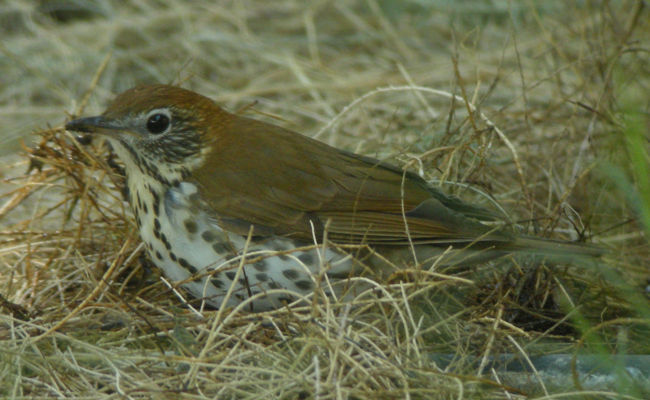
Wood Thrush, Shoshone, photo by Curtis Marantz
Before the Wood Thrush departed, Len found a Dusky-capped Flycatcher in his yard 5 November. He took video and stills and got the word out but the flycatcher was not re-found. If accepted by the Committee, this will be the fourth record for Inyo County and the 85th for California. This event is a perfect example of why it is crucial to collect evidence to support a claim of an unexpected species. Len is well-known to the Inyo County birding community but only to a few people outside the county. A single observer of a bird species that is not an easy identification, and is not re-found by others, is a difficult record to evaluate. With unequivocal images, Len proved to all, currently and in a century, that a Dusky-capped Flycatcher occurred at this location on this date.
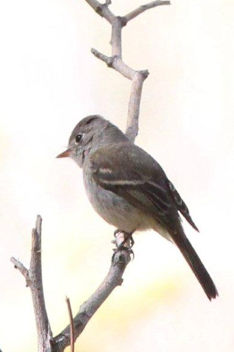
Least Flycatcher
photo by Debby Parker
The highlights didn’t stop with these mega-highlights! The southeast corner of the county garnered almost half of the “fancy” species with Furnace Creek Ranch hosting a Horned Grebe (KB), White-winged Dove (JLD), Ruddy Ground-Dove (JLD, C&RH), American Tree Sparrow (KB), Grasshopper Sparrow (CAM, C&RH), and Swamp Sparrow (CAM). Shoshone came in second with Northern Waterthrush (LSW), Northern Parula (LSW), Magnolia Warbler (C&RH), and Black-throated Blue Warbler (C&RH), while Tecopa had Red-eyed Vireo (CAM) and Hooded Merganser (CAM), and China Ranch a Palm Warbler (C&RH).
The Bishop area served to help balance the county’s fall records with Birchim Canyon adding Tennessee Warbler (J&DP), Chestnut-sided Warbler (J&DP), and Summer Tanager (J&DP), and Round Valley gave up a Least Flycatcher (J&DP). Owens Valley’s watering holes, Tinemaha Reservoir and Owens Lake, yielded Arctic Tern (JLD), American Golden-Plover (KH-L), Sanderlings (JLD, KH-L), Semipalmated Sandpiper (JLD), and Sabine’s Gulls (KH-L).
Saline Valley reminded birders that it is worth visiting by adding an immature Northern Goshawk, American Redstart, Clay-colored Sparrow, and White-throated Sparrow, all reported by REM.
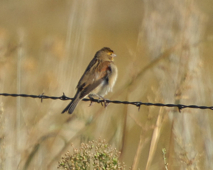
Dickcissel
Photo by Debbie House
Some species were discovered throughout the county with Clay-colored Sparrows at Round Valley (JLD), Saline Valley (REM), and two at Furnace Creek Ranch (JLD, C&RH); Lark Buntings at Round Valley (JLD, DJH) and Furnace Creek Ranch (C&RH); Vermilion Flycatchers at Bishop City Park ((LR), C&RH) and Death Valley Junction (C&RH); Dickcissels at Round Valley (JLD) and Furnace Creek Ranch (C&RH); Bobolinks at Pleasant Valley Reservoir (DJH) and Furnace Creek Ranch (JLD); Lawrence's Goldfinch at Deep Springs College (C&RH) and Shoshone (ADeM); and Indigo Buntings were everywhere!
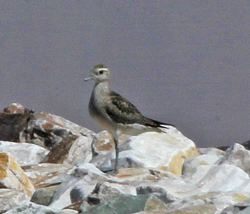
American Golden Plover
photo by Jo Heindel
The fall seasonal report is more complete because of the extraordinary effort that the following observers gave to validate sightings. Of the 65 species submitted to the editors of North American Birds in the Fall Report, 36 were supported with photographs! Our public and personal gratitude goes to: KB-Ken Burton, ADeM-Al DeMartini, JLD-Jon Dunn, KH-L-Kelli Levinson, DJH-Debbie House, C&RH-Chris & Rosie Howard, CAM-Curtis Marantz, REM-Bob Maurer, Jr., J&DP-Jim & Debby Parker, LR-Lynette Royce, and LSW-Len Warren, plus many others not cited in this article.
Back to Top
Bird Identification Challenge
Mystery Sparrow
By Debby Parker
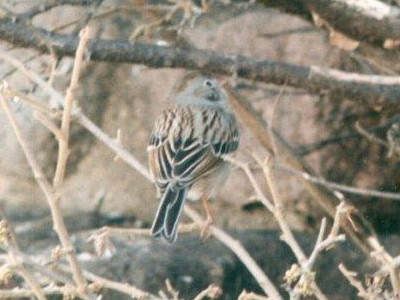
Our Mystery Bird - first look
Why do we birders get excited when a sparrow jumps up in front, giving only a brief look? Or when we see them skulking around in the shade of some weeds, gleaning seeds from the edge of our favorite birding trail? We stop, with bated breath, our minds sifting through the few marks we see, trying to put them together into an identification. We stand like a statue, raising our binos, peering into the brush, where this mystery sparrow is now hidden! We wait for one more look.
I’ve chosen a sparrow to study that Jim and I have only seen in a few places like Texas and Pennsylvania, but there is one record for Inyo County. We have to wonder if there is only one record because only one bird has ever visited our county or do they get missed? Let’s say we get three brief looks at our sparrow; let’s try to sort it out.
With its back to us, a gray collar that extends across the nape stands out. The mantle is made up of medium brown and pale gray streaks running vertical along the back. The folded wing shows three striking black tertial feathers*, showing contrast with pale-edging. The tertials contrast with the lighter mantle above. Below the tertials folded secondary flight feathers are stacked-up on top of the primaries which we can’t really see. The brown of the folded secondaries seem to be color-coordinated with the medium-brown mantle streaks. The tail-top matches the tertials, rich black with pale edging. The tail shape shows a noticeable notch. Bill, legs and feet really do look pink - nice touch.
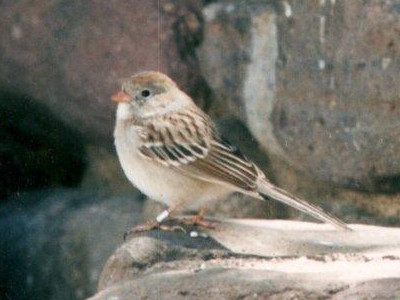
Side View of Our Mystery Bird,
showing wing bars
A side view allows us to study the wingbars, which many sparrows have. Wingbars are an important mark to note in one of those famous brief looks.
Now what do we see? The coverts are partially hidden at the top of the wing by the scapulars that spread from the mantle and are matching its coloring. What we see is an upper partially hidden white wingbar and a second one below, separated by that beautiful rich black again. In other words, the greater wing-coverts are distinctly pale-edged at the tips and more narrowly up the sides of the covert feathers creating a dark panel between the two wingbars. The median wing-coverts are also pale-tipped, making the upper wingbar match the lower one. The highest part of the wing is called the lesser wing-coverts, and is usually hidden! The wing still looks the same as in the photo of the back, so let’s move onto that interesting and somewhat plain head. The markings are subtle with a distinct white eye ring, rufous wash across the crown and a hint of rufous in the auriculars surrounded by medium gray. The bill is still pink and below it is a white chin. Separating the white chin from the gray neck-sides is hint of rufous which might be a malar stripe.
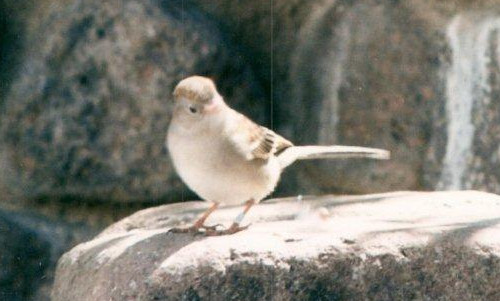
Last Look - So what do you think it is?
Our last look at our sparrow shows the top of the crown, face, breast and sides, belly and flanks. The rusty crown seems to show a gray median crown stripe. The underside or front of this bird is plain! The color is pale lacking any streaks. In the plainness, there might be a bit of a brighter wash in the sides and flanks which blends into the underside center.
That’s our look. What is the bird? Which marks are going to give us the most mileage? There are two sparrows in the same genus that look similar, what are they?
Hints and Answer
Click the hints one at a time to reveal!
- First Hint
- Compare the size to another sparrow, like a White-crowned Sparrow.
Our mystery sparrow is distinctly smaller and slimmer with a notched tail.
This could lead us to the genus Spizella.
- Second Hint
- Our Spizella has a fairly plain face with a distinct white eye ring
and pale lore versus a dark lore.
- Third Hint
- Our Spizella has a plain breast, no heart spot,
and it has an all pink bill with rufous median crown stripes.
- Answer
- Yes, this is a Field Sparrow (Western Race).
The only record for Inyo County is from Furnace Creek Ranch, October 16-17, 1992,
found by Jon Dunn and seen by others. It was also photographed for documentation. This brings home the importance of photographing our rare bird finds, which, especially for a first county record, the pros agree, needs to happen. In other words, use your camera!
First Hint
Compare the size to another sparrow, like a White-crowned Sparrow.
Our mystery sparrow is distinctly smaller and slimmer with a notched tail.
This could lead us to the genus Spizella.
Second Hint
Our Spizella has a fairly plain face with a distinct white eye ring
and pale lore versus a dark lore.
Third Hint
Our Spizella has a plain breast, no heart spot,
and it has an all pink bill with rufous median crown stripes.
Answer
Yes, this is a Field Sparrow (Western Race)!
The only record for Inyo County is from Furnace Creek Ranch,
found by Jon Dunn and seen by others. It was also photographed for documentation. This brings home the importance of photographing our rare bird finds, which, especially for a first county record, the pros agree, needs to happen. In other words, use your camera!
*Please refer to first pages in your field guides, which will show a drawing of a bird and will name the feathers, if you need help with terms used in this article.
The single record of this mystery sparrow was found in the Unpublished Inyo County Birds Graphbook by Tom and Jo Heindel. All Mystery Bird photos for this article were taken by Debby Parker at a photography blind set up at the Davis Mountain Texas State Park visitor’s center on March 20, 2002.
Back to Top
Poetry
Winter in the White Mountains
Inspired by Loren Eiseley
Outcroppings laden with rats' nests, churning
Old wood and low-Cambrian fossil beds —
Living sepulchres stuffed with nameless bones.
In these warm wooden middens of winter,
Time, fingering the scraps of its register,
Testifies that that hoary humid shore
Has become, for this current eon, land
And therefore mine. So I in turn, hardened
As January's wind, the sage, the slate,
The turds, the very sky, ashen all,
Scrunch like the eagle, anticipating
Future thermals, or like the grey coyote
Wander, circle, waiting on the juice,
The bud, the sap, the lark, some fleshly thing.
Larry Nahm
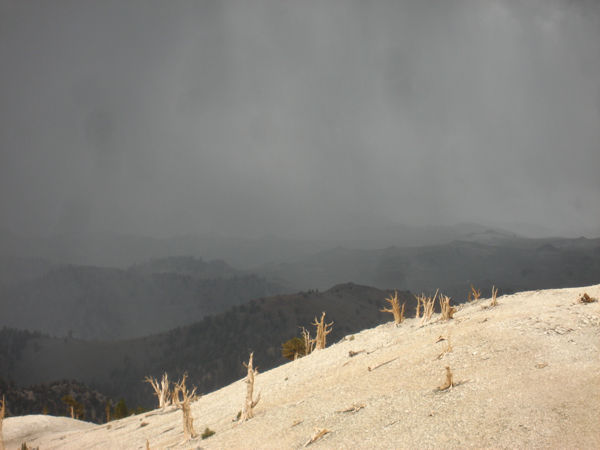
Storm in the White Mountains, photo by Maggie Riley
Back to Top
Reports
Field Trip Report:
Rock Creek, October
30th
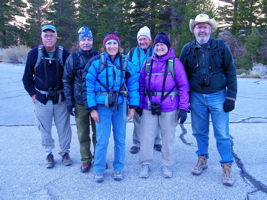
Rock Creek Field Trip Participants
On a rather brisk October morning, nine birding enthusiasts arrived at the Rock
Creek Sno-Park for the fifth annual Rock Creek Field Trip. Participants came from
Mammoth Lakes to the north and from Bishop and Big Pine to the south.
The morning chill kept the birds down as we walked through open sage but by the
time we reached the Lodgepole Pine forest Townsend’s Solitaires were calling. We
heard several during the day. As we proceeded up the creek, birds became more
prevalent and we began to hear flocks of Mountain Chickadees. Highlights along
the way included a good look at a Hermit Thrush and a Brown Creeper.
The day remained sunny but cool and by the time we reached the pond below
Rock Creek Lake it was time for lunch which we enjoyed while being warmed
by the fall sun.
We saw a total of 10 species of birds including American Robin, Common Raven,
Steller’s Jay, Clark’s Nutcracker, Ruby-crowned Kinglet and Dark-eyed (Oregon) Junco.
Noticeably absent were the American Dipper and any type of Nuthatch. We searched
and searched but no luck.
Surprisingly on the way back we found a few wildflowers still in bloom including
Cinquefoil and Rock-cress. It has been an unusual year.
Bill Mitchel
Back to Top
Field Trip Report:
Birding at McNally Canal and Farmer's Pond, November 12th
Skies began to clear just as eight participants assembled near Laws to walk the McNally Canal. Before introductions had concluded, a pair of Snow Geese winged south. The leisurely stroll featured many flights of small Passerines. Pipit, Shrike, Meadowlark and Kingfisher were heard or seen singly. A flicker, an intergrade, showed the red mustache of the red-shafted as well as the wings and tail of the yellow-shafted. When we arrived at Farmer's Pond to end the morning, a perched Ferruginous Hawk was waiting. Then came a dark Merlin, that "Kestrel with attitude," which filled a scope for all to enjoy. Perhaps partly due to shooters, ducks were absent. The outing yielded about 32 species, seven of which were hawks.
Larry Nahm
Back to Top
Mono Lake Tufa State Natural Reserve to Remain Open

Mono Lake Tufa
The Mono Lake Tufa State Natural Reserve has been removed from the list of state parks slated for closure in 2012!
The Bodie Foundation has signed a concession agreement to collect fees at the Old Marina parking lot just north of Lee Vining along the west shore of Mono Lake. Funds collected will not be deposited into the state general fund but will be used directly to fund operating expenses associated with keeping the Reserve open.
The Bodie Foundation is a cooperating non-profit that has been supporting the operation of Bodie State Park, Grover Hot Springs, and the Mono Lake Tufa State Natural Reserve for two years. The subchapter of the Bodie Foundation operating at Mono Lake is known as the Friends of Mono Lake Reserve. Fee collection will be on the honor system and visitors to the site will be asked to deposit their money into an “iron ranger” located at the parking lot.
State Park funding for Mono Lake has continued to shrink over the years and has been replaced by donations, funds from sales of T-shirts and baseball caps, profits from birding by ear workshops and grants from the Bodie Foundation.
All state owned portions of recessional lands surrounding Mono Lake will remain open. Recessional lands are those lands that have been exposed as the lake has dropped due to water diversions by the City of Los Angeles. The state owns and manages the surface waters of the lake plus 4,000 acres of the Mono Lake shoreline including the Old Marina site, the boardwalk and viewing platform below the Mono Lake County Park, some tufa groves and some of the most pristine wetlands in California.
Due to continued cutting of the State Parks budget the Mono Lake Tufa State Natural Reserve is one of 70 state parks that appeared on the closure list issued last spring. Many visitors and Mono Lake enthusiasts had been questioning the justification of closing a park that costs so little to operate yet is enjoyed by over a quarter of a million visitors each year.
The State Natural Reserve is also one of two organizing partners of the Mono Basin Bird Chautauqua.
Dave Marquart
Back to Top
Bishop Christmas Bird Count Results

Costa's Hummingbird
Photo by Chris Howard
The Bishop Christmas Bird Count was held on December 17, 2011.
Fifty-one participants tallied 106 species. An additional 4 species
were observed during Count Week. The weather was pleasant with a low
of 14°F and a high of 56°F. Sunny skies, virtually no wind. A Sage Thrasher was a nice find in downtown Bishop and the only new species
to the count this year (Wells/Murphy/Overholtzes/Baptie).
Other rarities included:
- a Rough-legged Hawk (Engelhardt/ Zimmerman/ Richardson/ Becker),
- a Northern Pygmy Owl (Gorhams),
- a young male Costa's Hummingbird (Howards/ Petersons),
- a
female White-headed Woodpecker (Howard),
- four Western Bluebirds (Nahm/ Mitchel/ Gann/ Mogg/ Massieon),
- two Vesper Sparrows (Heindel/ Hopkins),
- and a Lark Sparrow (Wells/ Murphy/ Overholtzes/ Baptie).

Blue-gray Gnatcatcher
Photo by Nancy Overholtz
High Counts (HC) were obtained for the following:
- Ruddy Duck (265,
previous HC 157),
- Red-shouldered Hawk (23),
- Prairie Falcon (6),
- American Coot (945, previous HC 605),
- Anna's Hummingbird (4),
- White-breasted Nuthatch (3),
- Canyon Wren (7),
- Orange-crowned Warbler (54, dwarfing the previous HC of 22), and
- Sage Sparrow (174, previous
HC 69).
Species not tallied on Count Day, but found during Count Week
were:
- Hooded Merganser (5),
- Ring-billed Gull (1),
- Greater Roadrunner (1),
- and Blue-gray Gnatcatcher (2).

White-headed Woodpecker
Photo by Chris Howard
For a detailed summary (pdf) of the results, click here.
Many many thanks to all the talented and generous people who
contribute to the Bishop CBC! Mark your calendars for the 2012 Bishop
CBC on Saturday, Dec 15, 2012.

Sage Thrasher - a first for the Bishop CBC!
Captured on film by Nancy Overholtz
Chris Howard
Bishop CBC compiler
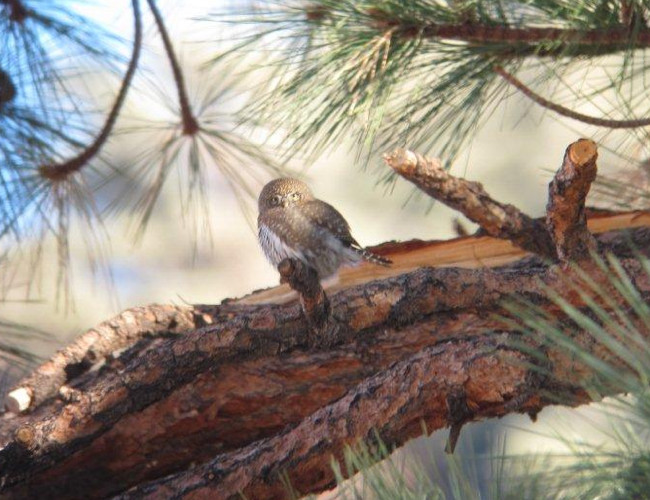
Northern Pygmy Owl, photo by Jon Dunn
Back to Top
2011 Mono Lake Christmas Bird Count Summary and Report
This year's Mono Lake Christmas Bird Count was a fantastic success. First off, we had virtually no snow. This opened up a tremendous amount of territory on the circle, since half the circle is high, and normally inaccessible or difficult to access snowy mountain wilderness. We nearly always have participants on skis, but when the starting point is near Lee Vining, access is relatively limited. This year with the Tioga Pass open, we had full and extensive access of upper Lee Vining Canyon, Burgers retreat, as well as Virginia Lakes to Turnbull Campground, to the circle's north. This allowed us to count Whitebark Pine regions, which yielded species that have not been seen on the count since the early 1980’s or so (Pine Grosbeak, Red Crossbill). We also had high turnout of participants, and the results showed!
Northshore Team: Oliver, Nora, Jean, Colin and Tim Dillingham: These guys pulled out the expected species and then some, including an awesome diversity of waterfowl, including Hooded Merganser, plus Short-eared Owls, Virginia Rails, Rough-legged Hawk, 21 Western Meadowlarks (a winter high count), and a stunning flock of shorebirds, at least by winter Mono standards, 12 Least Sandpipers, 2 Dunlin and a Snowy Plover – Mono County’s and the CBC's first ever for winter.
Lundy Canyon: Bartshe was able to access all the way up past the resort. He had great luck on wrens, including Pacific and Canyon Wrens, both rare for the count, especially Canyon Wren. So the count ended up with the wren grand slam. Bartshe managed the only Belted Kingfisher. Then, up by the resort, an unusual vocalizing bird turned out to be a Pine Grosbeak, which has not been seen on the count since 1983, and is only the 3rd record for the Mono Lake count, and a stunning bird for the Mono Basin.
I realize I don’t have time to go over everyone’s day. Other count highlights included Ring-necked Duck, Common Merganser, Common Goldeneye, Greater Sage Grouse, Yellow-rumped Warbler (yes, can be missed on our count), Red Crossbill (only 4th count record, and found in 2 locations this year), and much more.
Despite missing a few fairly regular species, our count tally is 77 species – tying the previous high count set in 2003 and 2004. Way to go Mono Basin counters!
Kristie Nelson
Back to Top
Shoshone-Tecopa Christmas Bird Count (Trial CBC) Results
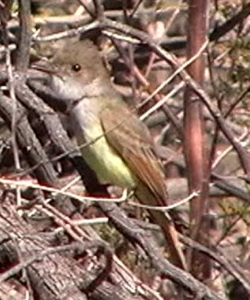
Rare Dusky-capped Flycatcher
seen in Shoshone (but not during CBC)
photo by Len Warren
Here are the results of the first (trial run) Christmas Bird Count for
Shoshone-Tecopa, held on Sunday Dec 18th.
Thirteen Birders in four teams from Nevada and California counted birds at Shoshone Village, Shoshone Wetlands, Grimshaw Lake, Tecopa Hot Springs, Tecopa Marsh, Amargosa Canyon, and China Ranch.
We observed 62 species
and 1046 individual birds.
As our CBC experience and local knowledge improve, we are already looking forward to next year's first official Shoshone-Tecopa CBC.
We would like thank all who came on this fine desert day to count birds, and a special thank you to all at Crowbar Restaurant for the awesome hot food afterwards.
Shoshone-Tecopa CBC Species List (click here to show or hide species list)
- Snow Goose 6
- Ross's Goose 2
- American Wigeon 4
- Gadwall 8
- Mallard 13
- Northern Shoveler 16
- Green-winged Teal 1
- Ring-necked Duck 1
- Ruddy Duck 1
- Gambel's Quail 32
- Pied-billed Grebe 1
- Great Egret 1
- Sharp-shinned Hawk 2
- Cooper's Hawk 1
- Northern Harrier 3
- Red-tailed Hawk 4
- Prairie Falcon 1
- American Kestrel 2
- American Coot 13
- Virginia Rail 1
- Eurasian Collared Dove 28
- Mourning Dove 1
- Greater Roadrunner 3
- Long-eared Owl 1
- Great Horned Owl 1
- White-throated Swift 10
- Anna's Hummingbird 3
- Red-naped Sapsucker 2
- Ladder-backed Woodpecker 3
- Northern Flicker 9
- Black Phoebe 6
- Say's Phoebe 12
- Loggerhead Shrike 5
- Western Scrub Jay 1
- Common Raven 19
- Bushtit 42
- Verdin 17
- Bewick's Wren 14
- Marsh Wren 14
- Marsh Wren 12
- Rock Wren 1
- Ruby-crowned Kinglet 14
- Black-tailed Gnatcatcher 15
- Western Bluebird 62
- American Robin3
- Northern Mockingbird 4
- Crissal Thrasher 14
- Phainopepla 86
- European Starling 2
- Orange-crowned Warbler 2
- Yellow-rumped Warbler 117
- Savannah Sparrow2
- Song Sparrow 23
- Lincoln's Sparrow 2
- White-crowned Sparrow 302
- Dark-eyed Junco(Oregon) 3
- House Sparrow 103
- Red-winged Blackbird 6
- Great-tailed Grackle 1
- Brewer's Blackbird 1
- House Finch 42
- Lesser Goldfinch 36
Len Warren
Staff Naturalist
Shoshone Village, CA
birdsofshoshonewetlands
Taking Care of Business
Welcome New and Renewing Members!
Eastern Sierra Audubon would like to thank the following new and/or renewing members for their support:
- Terri Dean
- Anne Lyness
- Matthew Weber
- Ann Hoffmann
- Elisabeth Bingham
- Rich and Carol Ann Mitchell
- Bruce Horn
Your membership donations help keep this chapter alive. We get 8-10 renewing members a month, and from 3-5 new members. Your membership dues make it possible for us to offer and support great educational and recreational events throughout the eastern Sierra. Thank you!
If you would like to join and help support Eastern Sierra Audubon, there are two ways you can do it:
- Join as a National Audubon Society Member, designating ESAS as your chapter affiliation. Includes Audubon Magazine subscription. This is $20 for the first year, and goes up to $35 annually thereafter.
- Join as an ESAS Chapter-only member for $20 per year. Now that we do the newsletter online, you no longer need to join to receive it, but your chapter membership is a way to give back, and show your appreciation for all that ESAS does, and to help support our many programs.
Click Here for a membership form to join or renew!
Join National Audubon - your zip code will associate you with the chapter nearest you.
Back to Top
How You Can Help ESAS: Four R’s (and a V)
Renew your membership (or join): The money from your membership dues is what helps us bring great evening programs, special events, educational programs, trips, this website, and more to the community - we need your support!
Recycle at Manor Market and tell them to donate the money to Eastern Sierra Audubon.
Respect property and get permission to bird on private or restricted access property.
Repeat: Spread the word about programs and events, encourage others to join and participate.
Volunteer: Come to a board meeting and consider volunteering for an open board position! We welcome new board members, and we also always need volunteers for Birds in the Classroom, participants in bird counts, Bird-A-Thons, etc.
Message from the Editor
Winter is Here?
What a contrast to this time last year, with very little snow, and the passes and trails remaining open giving access to high alpine lakes for ice skating (and birding, of course)! We've got four field trips in January and February to take advantage of the dry winter, and a great evening program coming up in February. Enjoy these warm(ish), clear winter days while we have them.
Our next newsletter deadline will be February 17th for the
March-April issue, and of course you are always welcome to send submissions for future newsletters
and also the monthly email at any time.
We send out no more
than one email each month to remind you of upcoming events - if you are not
on our email list, please
add yourself so you don’t miss anything! If you send items to the newsletter
editor by the last week of any month, we’ll make sure they get included in
the next issue.
Please Contribute!
Speaking of sending in items for the newsletter...
All of our content is supplied by our awesome members... if you have any ideas about articles you’d like to see, or better yet, if you have anything to share for newsletter publication, whether an article, a news item, update, correction, poem, essay, artwork, photo, field trip report, neat birding experience, letter, etc, please send it, along with any comments or suggestions, to the newsletter
editor. We’d love to hear from you!
You may send items for inclusion in the newsletter at any time, but please
send any timely items to arrive before the first of the month, so they can
be included in the monthly email update.
Thanks for reading, and happy birding!
Maggie Wolfe Riley, Newsletter Editor
Back to Top
About Eastern Sierra Audubon
Current Board Members
Membership
Main Calendar of Events
Calendar for January and February
Back to Top

Gray Catbird in Bishop - another fall rarity
Photo by Nancy Overholtz, November 13, 2011
(check out the big Jerusalem Cricket in the background!)
